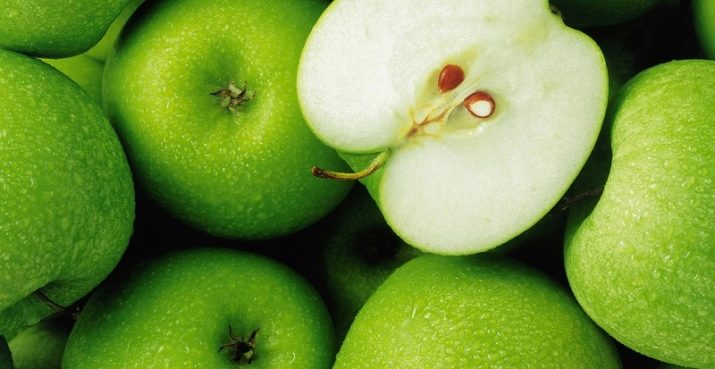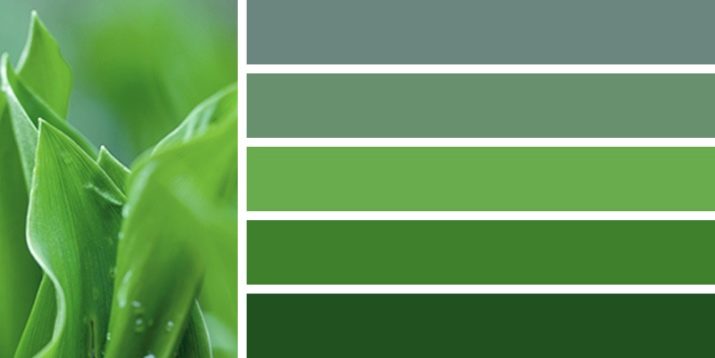A person has a unique opportunity to recognize many colors around him. Unlike most animals, nature has endowed us with color vision, with which we can capture all kinds of shades. But the colors around us not only give us aesthetic pleasure and provide visual information. It is proved that various shades are able to have a certain effect on the physical and psychological state of a person. In our article, we will talk about green and its importance in human psychology.

What does it mean?
Shades of greenery have a natural nature. Most of the plants around us are green. This color gives trees, flowers and grass a pigment called chlorophyll. And this is not his only property. The main effect of the chlorophyll pigment is that it allows plants to enrich themselves with nutrients under the influence of sunlight or artificial ultraviolet radiation.
This color is a mixture of blue and yellow. Depending on their concentration, various color variations of greens can be obtained. First of all, color is associated with vegetation, freshness, development. From green shades it blows with natural life energy, youth. At the same time, calm variations of green can cause peace and tranquility.
In the minds of most, greenery is associated with nature and harmony.. Therefore, the colors of this gamut cause mostly positive emotions and are not annoying.
The color has many shades from very light to dark. The most popular variations of greens:
- turquoise;
- light green;
- olive;
- aquamarine.

Interpretation of color and associations with it to a large extent depend on the specific shade and its intensity. More saturated and vibrant color variations can cause arousal, stimulate mental activity. Pale and calm shades, on the contrary, inhibit the nervous system and act in a peaceful way.
Consider the meaning of various shades of color.
- Dark green means passivity, stillness. It is associated with physical pleasures, a measured way of life and relaxation. Color adjusts to immersion in oneself, tracking one’s emotions and bodily sensations, inspires thoughtfulness.
- Blue-green, or aquamarine, is fresher and brighter. It is also called turquoise because of its resemblance to turquoise - a natural material of a similar color. The shade is considered cold and is associated with fresh wind, cool sea, sky. Turquoise has an invigorating effect, it helps with oppressed conditions. Thanks to pleasant associations, it helps you to tune in to activity, it charges you with vital energy.
- Yellow-green color is the lightest shade of the gamut. It means the desire for change, the rejection of stereotypes, the freedom of thought and action. It is a shade of energy, creativity and self-expression. And also yellow-green means openness, willingness to communicate, good attitude towards people around. The very pale color of this gamut means maximum satisfaction and tranquility. It is good to meditate on such a shade, as it brings thoughts and feelings in order.
- Olive, or brownish green, is associated with emotional exhaustion. It means the need to save vital energy. For people with an overly excitable nervous system, this shade can have a positive effect, as it literally “absorbs” excess emotions, tension and negativity.
But for those who are prone to apathy, olive can take away the already meager energy.

What does symbolize?
It is believed that most shades of green range symbolize joy, energy, development, the beginning of something new.
For our ancestors, this color was considered a symbol of agriculture, fertility, and harvest. Many pagan deities, as well as ancient gods, were depicted in this color, as they were expected to help them in continuing the prosperous life of people.
Orthodoxy also did not ignore the green gamut. Often, various shades of green are painted on the icons of the robes of the Virgin. In this case, color is interpreted as a symbol of wisdom, purity, merciful motherhood, love and compassion for humanity. In the same religion, he is presented as a symbol of eternal life. The custom to put Christmas trees in houses is just tied to the fact that the tree does not change its color for a very long time.
This attachment to the symbol of eternity in modern Orthodoxy has generated a sad custom. At the funeral, after the coffin, it is customary to throw spruce branches in a sign that the soul is immortal.

In Islam, green is identified with paradise, and the color symbolizes the eternal tranquility of the soul and its being in harmony in heaven.
Most environmental movements choose a green color for their logo based on the fact that it is the natural color of all living vegetation on the planet. The largest party working in this area is the world famous party of "greens", or Greenpeace.
Despite the mostly positive color symbolism, the people have mocking and even somewhat negative associations with it. For example, the word "green" is called too young, ignorant of his business.
The phrase "longing green" also has a negative message. It is used in those cases when a certain stagnation occurs in life, which does not have any prospects for positive development.
It is believed that this expression was born from an association with a swamp, where stagnant water is located and gloomy and dirty shades of green prevail.

Perception Features
As mentioned above, each shade perceived by a person affects his psyche. In general, green is the color of relaxation and reassurance. Its soft colors are used in color therapy to relieve stress, nervous strain, emotional exhaustion and anxiety. Vivid variations of green can energize, stimulate performance, improve mood and increase vitality.
- Color improves sleep. If the child falls asleep badly or sleeps restlessly, it is worth providing green light in his room. And also color improves the process of falling asleep in adults. It is enough to hang light green curtains in the bedroom or paint the walls in a calm tone of this range.
- Green gamma has a positive effect on the nervous system. Color adjusts to positive thinking, helps to overcome phobias and anxiety. Often it is in this shade that the walls of the rooms of children's and adult psychologists and psychotherapists are painted. And also shades of green are often used in the design of corridors and chambers of medical institutions.
- For men and women with a tendency to short temper and emotional instability, contemplation of shades of green is also very useful. Meditation on this color calms the nervous system, relieves overexcitation. Surrounding themselves with green tones, quick-tempered people eventually begin to better control emotions and their behavior.
- In the interior, decorated in green, a person subconsciously relaxes, feels comfort and security. Even a few objects or details of green shades can bring orderliness and a sense of comfort into the general atmosphere of the room.
- In color therapy, this gamma is successfully used to relieve pain of various nature and localization. Green shades have a regulatory effect on the work of the heart, helps to stabilize the pressure with hypertension. They stimulate the body's defenses, helping it fight colds and viruses.
- Contemplation of green has a healing effect on the organs of vision. With prolonged work at the computer or eye strain, doctors recommend looking at some green object for several minutes. And in summer it is best to go to the window and look at the natural greenery for a while.

What kind of people like it?
The green gamut is very attractive, so you can meet many who love this color very much. Collecting data on personality traits, psychologists identify some character traits that are often inherent to lovers of shades of green.
- Those who prefer this gamut are quite reasonable and balanced. They strive to be objective, therefore it is easy to conduct business with them and just communicate.
- Love for bright shades of color speaks of great willpower and determination. Such a person is not inclined to excessive reverie, he is clearly aware of his capabilities and determines his plans and tasks based on them.
- Those who are attracted to green shades are wonderful interlocutors. They can easily become the leader of a company or team. Often they have a fairly wide circle of friends, and they easily make new acquaintances and make contacts. People around them are drawn to them, because they are attracted by openness, creativity and sincere kindness.
- Another positive quality of those who love the green range is their honesty. They do not accept intrigue and achieve their goals by persistent and conscientious work.
- People who prefer shades of green are very merciful. They are ready to support their relatives and friends in difficult situations. Negatively reacting to cruelty and injustice, they try to do everything in their power to correct or prevent the bad.
Green lovers are often members of charitable organizations, actively donate funds for various social needs.

Unfortunately, unscrupulous people often use this quality, playing on a sincere desire to help in trouble. Therefore, in an effort to support others, green lovers can easily become victims of scams and scammers.
- Those who prefer green shades are very curious. They like to travel, develop, learn and learn new skills and professions. They strive to work on their shortcomings and constantly improve.
- Thanks to its positive qualities, namely: kindness, responsiveness, mercy and calmness - lovers of green shades become good parents and mentors. Professions related to communication are suitable for them - a teacher, a doctor, a social worker, a consultant. Often they realize themselves in the field of art. At least, most of all, each of them has at least one or even several hobbies related to creativity and creativity.
- If a person prefers the rich and vibrant color of greens in clothes, this indicates that he has a large amount of vital energy. Such people are very active and can hardly sit still. They are also able to positively influence others, supporting them and charging with their positive.
- Men who prefer the colors of green are very balanced and caring. They become beautiful sensitive husbands, protecting their family.

Negative characteristic
Despite the mass of positive properties, some variations of this color have negative sides.
- Surplus surrounded by very bright shades such as aquamarine can cause nervous system overexcitation. Especially clearly people who are prone to nervous breakdowns, anxiety and emotional changes can react to this. Bright tones exude energy, but its excess can cause negative irritation of the psyche. In a person in this case, outbreaks of impulsivity, irritability, nervousness can be observed.
- As mentioned above, calm shades of green are successfully used in relaxation therapy. However, this property of color also contains a not entirely positive effect. Those who have pronounced neuro-emotional exhaustion and apathy should not surround themselves with such a gamut. Pale and light tones of green in this case will lead to an even greater loss of strength and loss of energy.
Sometimes people with similar disorders, surrounding themselves with green space, become even more isolated, move away from communicating with loved ones, become passive, indecisive and withdrawn.












